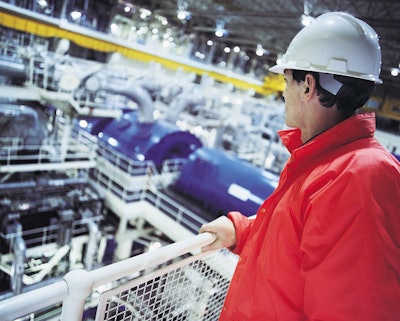
Close your eyes. Picture a traditional job in manufacturing. Is the dust flying; are the squeals of machinery mind-numbing? Can you smell the sweat in the air? Does the whole thing seem boring, dirty, and tedious? Is the factory pumping tons of lethal gases into the atmosphere? You can taste the grime and dirt, and you feel the heat of neck-scorching furnaces.
Now, picture a different scene. Imagine clean, crisp, and highly advanced pieces of Technology. Think of a computer-controlled robot, crawling across the floor, bring needed parts to the point-of-assembly. Take a deeper look, and notice the dozens of engineers in classroom-like settings, trying to figure out the best way to make things run smoother. Imagine the real-time alerts on the handheld scanners, signaling for employees to take a break, locate a needed part, or replace a belt in the conveyor before it tears.
If both of these scenes seem completely different, you have been paying attention. However, do you know what these two different environments represent?
Each setting is an accurate image of manufacturing from different time periods in history, the past and the present. Manufacturing has changed a great deal over the last 100 years, and manufacturing today is dramatically different than what was “normal” in 1990. The industry image of manufacturing is drastically changing, and the next generation needs to know why and how this is taking place and what's being done to ensure its continued vitality.
What’s Driving the Change in the Image of Manufacturing?
Many different factors have catalyzed the change in the manufacturing industry from a boring, dirty environment to a fast-paced, technologically-superior environment. Today, there are more people in the world, and they are demanding more products, faster, better, and more durable. Businesses are looking for ways to increase production, and consumers are demanding a more sustainable, cheaper product. Governments around the globe are taking steps to change the industry image of manufacturing, but something else needs to be done to ensure Manufacturing does not die.
Why and Where Does the Stalemate Stand?
Modern manufacturers face an interesting stalemate: they need to continue production, keep investors and employees happy, and attract new applicants and workers. By 2025, conservative estimates of the labor shortage in manufacturing stand out at more than 2 million unfilled jobs, as discussed in a previous blog post. According to Dr. Bill R. Path, a 2011 report, initiated by the National Association of Manufacturers, found a qualified worker shortage of 67 percent across the industry. Ironically, manufacturing represents one of the most stable, growing sectors of the economy and boasts a low unemployment rate of 4 percent in December 2015, explains the US Department of Labor: Bureau of Labor Statistics.Additionally, the industry has added approximately 50,000 jobs per quarter over the past few years, and the trend shows no signs of stopping. As a result, the need for more workers in manufacturing will grow, but how will manufacturers attract these new individuals?
Manufacturers Will Open Their Doors, Literally
In 2005, the Manufacturing Institute created and launched the Dream It. Do It. campaign. The goal of this campaign was simple: spread awareness about the manufacturing industry and encourage students to enter it. They also put out this fantastic video about Millennials' thoughts on the image of manufacturing.
Manufacturers, Trade Schools And Congress Step In To Help
With the passage of the American Recovery and Reinvestment Act in 2009, Congress created a $2 billion fund to help community colleges, trade schools, and other eligible institutions of higher learning to prepare students for “employment in high-wage, high-skill occupations,” such as manufacturing, asserts the US Department of Labor: Employment and Training Administration. On September 29th, 2014, $450 million were appropriated in grants to community colleges and trade schools for students to further this cause.
Part of the success of this program revolves around manufacturers and trade schools. In fact, some manufacturers are taking the idea of this program and expanding on it in-house. For example, the Hirschvogel Automotive Group launched a program to teach students the art and skill set of working as a machinist in a die and punch shop
This program did not require students to obtain prerequisite course credits through other institutions, which helped further the goal of obtaining more applicants and teaching skills in-house, without requiring the use of grants or other financial funding sources. However, Hirschvogel’s program didn’t stop there. It went on to provide assistance in balancing school and work schedules, which further helped more students complete the program, ready to go to work at the company. Ultimately, the manufacturer is stepping in to give students the option of entering the manufacturing industry without any financial or personal risk.
It's easy to want to avoid the manufacturing industry when you consider the stereotypical image of manufacturing throughout history. However, you need to take that image for its true value: it’s history, not an accurate representation of modern manufacturing. Today's manufacturing industry has more technologies, robotics, predictive systems, and overall “cool” things going on than you probably realize.
To really see how dramatically things have changed in manufacturing, check out a typical, childhood game, Jenga, as it would be played in a manufacturing setting in the following video by Cat (also known as Caterpillar Equipment).
Don't you think it's time we stop the public image of manufacturing that is covered in the media as a dirty and boring industry? Manufacturing, as society, has evolved. It's time to show the world how interesting manufacturing truly is and will be in the future.
Adam Robinson oversees the overall marketing strategy for Cerasis. This blog was originally published here.






















